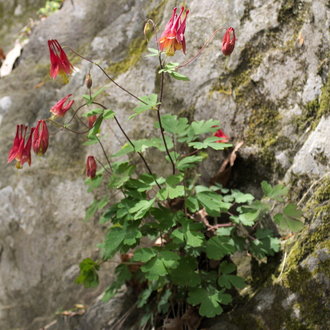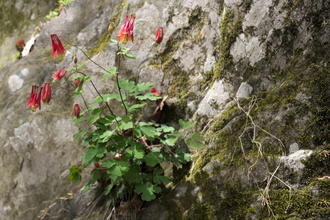Red Columbine (Aquilegia canadensis L.)
↑Summary
A red-flowering perennial often found in partly-wooded rock outcroppings, also temporarily in disturbed woodlands.
↑Range - Expand
| Legend | Color |
| Native | |
| Native or Not Present |
This tentative map is based on our own research. It may have limited data on Canada and/or Mexico, and there is some subjectivity in our assignment of plants as introduced vs. expanded. Read more in this blog post.
Although this plant occurs somewhere in each of these regions, it may only occur in a small part of some or all of them.
This species range extends both into Canada and Mexico, but we have yet to build either of these portions of its range map.
↑Description & Identification
No other red-flowering columbines overlap with this one in range, but farther west, a number of other red-flowering species can be found. When it is not in bloom, this species is readily confused with the introduced A. vulgaris, which has similar-looking foliage, and sometimes with the Thalictrum genus (meadow-rues.)
↑Habitat
Found mostly in openings in woodlands, usually steeply sloped, in rocky soils on sites that are moist to mesic and well-drained. Habitats include rocky streambanks, steeply-sloping ravines, limestone bluffs, or woodland openings where rock outcroppings limit plant growth. Often found in thin soils over limestone, granite, or quartzite, sometimes in areas with thin layers of loess atop bedrock, or in gravely glacial moraines. Frequently grows in cracks in steeply-sloped rock faces where a seep provides abundant moisture.
This species can occupy temporary habitats that have been disturbed to open up higher-light conditions, and transient populations of it can be found following local disturbances in a wide variety of wooded habitats. It is intolerant of heavy shade from a closed canopy of trees, and is also intolerant of root competition from other herbaceous plants, so it tends to only persist long-term on sites where rocky or thin soil inhibits both tree growth and the growth of other herbaceous vegetation.
Its leaves are covered in a waxy coating which can prevent absorption of herbicide through its leaves, so it can sometimes be found in areas regularly treated with herbicide, such as along roadsides or railroad tracks, due to its greater tolerance of these conditions. This herbicide resistance, combined with its affinity for woodland openings, can lead it to occur in a variety of anthropogenic habitats, including neglected urban areas where areas with asphault pavement or cement foundations have grown up to be partly-wooded, recently excavated sites, and disturbed woodland fragments and edges, especially where rock or gravel has been exposed or put down.
Humans have increased the habitat for this species in some areas, through creation of new, anthropogenic habitats, and humans have been more likely to leave its natural habitats intact as they tend to be rocky and sloped, and difficult to log and/or build on. However, in some areas, especially in Florida, populations have become threatened by competition from invasive species.
↑Life Cycle
Red columbine is an herbaceous perennial that is usually short-lived.
Seedlings germinate on the surface of the ground, and establish a short underground stem and fibrous roots. Individual roots are short-lived. Germination can occur in spring or fall but is less likely in summer. Plants die back to the underground stem in mid to late fall.
Seedlings establish best in shade; young plants are susceptible to drought and often die if exposed to dry, sunny conditions, but established plants exhibit greater drought tolerance.
New foliage emerges early in spring. Flowers emerge later in late spring to early summer. Bloom time varies considerably as a function of conditions. Plants usually bloom in their second year, but shaded plants may persist through one or more growing season without blooming.
Seeds are primarily distributed by gravity; they can bounce off hard surfaces as they fall.
Many seeds germinate immediately after distribution, in late summer to fall. Seeds that do not germinate immediately may germinate the following spring, in response to warming temperatures. We could not find information on whether or not this species can form a persistent seed bank. Some other Aquilegia species, such as the native golden columbine (Aquilegia chrysantha) and the non-native A. barbaricina and A. nugorensis are thought to form a long-term seed bank, and several gardening resources have claimed seeds can be viable for several years, so it is plausible that this species could form a seed bank as well, but we could not find any records of it doing so.
↑Faunal Associations
The flowers are visited by bumblebees and the ruby-throated hummingbird. Halictid bees also visit the flowers, but are less effective pollinators.
The foliage is toxic to mammals and largely ignored by most mammalian herbivores, including both wild herbivores and livestock, but sheep seem more tolerant of its toxins and may occasionally browse it. It is eaten by numerous insects. It is eaten by the larvae of several butterflies and moths. Two lepidoptera, the columbine duskywing (Erynnis lucilius), and the columbine borer moth (Papaipema leucostigma), specialize on this genus. It is also eaten by the pink-patched looper moth (Eosphoropteryx thyatyroides), which prefers eating the two related plants early meadow-rue (Thalictrum dioicum) and king of the meadow (Thalictrum pubescens), also of the Thalictroideae subfamily of the Ranunculaceae family. It has been recorded being eaten by the second generation of the introduced holly blue butterfly (Celastrina argiolus), which prefers holly for its first generation but is a generalist in the second generation. The generalist tobacco budworm (Chloridea virescens) also eats it. It is also eaten occasionally by the mayapple borer moth (Papaipema rutila), which primarily eats mayapple, and it has also been recorded being eaten by the red-edged acleris moth (Acleris albicomana) which is somewhat of a generalist and tends to prefer other species.
Outside of lepidoptera, the foliage is also eaten by larvae of the columbine sawfly (Pristophora aquiligae) and several leaf miner flies of the Phytomyza genus. These leaf-miners rarely cause severe damage.
↑Uses
This species is widely cultivated in gardens as an ornamental plant, where it is valued for its attractive foliage, showy flowers, and resistance to deer and rabbits. It is relatively easy to grow in gardens where competition from other plants is reduced by weeding. In gardens, it can be grown long-term in richer conditions than it would occur in the wild.
It is also planted specifically to attract and support hummingbirds.
↑Related Plants
Numerous other Aquilegia species also occur in North America, most native. This species is probably closest related to the smallflower columbine (Aquilegia brevistyla), which overlaps with this one in range only in a small region in western South Dakota, flowers blue, and is the only native species that overlaps with this one in range. It is probably not particularly closely related to any others, including the other red-flowering species.
Throughout most of its range, the only overlapping species in this genus is the introduced European columbine (Aquilegia vulgaris), which is the only columbine introduced in North America from another continent.
This genus is also closely related to the Thalictrum (meadow-rue) and Enemion (false rue-anemone) genera; both belong to the Thalictroideae subfamily of the Ranunculaceae family; this grouping also includes numerous other genera that do not occur in North America. Most of the species in this grouping that do occur in North America are native, excepting a few introduced Thalictrum species.
↑Links & External Resources
• Red Columbine | Fire Effects Information System (FEIS) (About This Site)
• Aquilegia canadensis (Wild Columbine) | Illinois Wildflowers (About This Site)
• Aquilegia canadensis (Red Columbine) | USDA PLANTS Database (About This Site)
• Aquilegia canadensis | Go Botany (About This Site)
• Aquilegia canadensis (Columbine) | Missouri Botanical Garden Plant Finder (About This Site)
• Aquilegia canadensis | Biota of North America Project (BONAP) (About This Site)
• Aquilegia canadensis L. | Plants of the World Online (POWO) (About This Site)
• Aquilegia canadensis | NatureServe Explorer (About This Site)
• Aquilegia canadensis | Flora of North America (About This Site)
• Aquilegia canadensis | Missouri Plants (About This Site)
• Red Columbine | Maryland Biodiversity Project (About This Site)
• Aquilegia canadensis (Red Columbine) | Minnesota Wildflowers (About This Site)
• Aquilegia canadensis L. (Wild Columbine, Eastern Red Columbine) | Digital Atlas of the Virginia Flora (About This Site)




